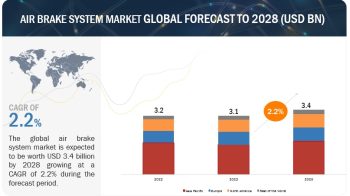MarketsandMarkets projects the global blister packaging market to grow from USD 11.94 billion in 2015 to USD 18.25 billion by 2022, at a CAGR of 6.25% from 2015 to 2022. As the application of blister packaging in the healthcare industry is growing day by day, the blister packaging market is also projected to grow at a healthy rate. Blister packaging is used in applications such as food products, toys & related goods, cosmetics & toiletries, electrical components, motor vehicle/spare parts, consumer electronics, pharmaceutical, and medical products.
The blister packaging market is segmented on the basis of material, technology, heat seal coating, application, and region. The market is segmented into North America, Europe, Asia-Pacific, and Rest of the World (RoW). The Europe region held the largest share among all the regions in 2014. This is mainly due to rising aging population and increasing manufacturing activities, coupled with growing applications of blister packaging in the healthcare industry.
Download PDF Brochure: https://www.marketsandmarkets.com/pdfdownloadNew.asp?id=24775059
The key players in the blister packaging are Amcor Limited (Australia), Bemis Company, Inc. (U.S.), The Dow Chemical Company (U.S.), WestRock Company (U.S.), and Sonoco Products Company (U.S.). The other prominent players in the market are Constantia Flexibles (Austria), Klockner Pentaplast Group (Germany), Tekni-Plex, Inc. (U.S.), Pharma Packaging Solutions (U.S.), and Display Pack, Inc. (U.S.). These players have adopted various strategies to expand their global presence and increase their market shares. Partnerships, agreements, joint ventures, acquisitions, expansions, and new product launches are some of the major strategies adopted by the players to achieve growth in the blister packaging market.
The growth of the blister packaging market was largely influenced by mergers & acquisitions in the past five years. The year 2014 experienced a large number of expansion & investment strategies being used by top players in the market. Collaborations & agreements also formed an essential part of their strategies, which led to the flow of considerable income within the company. Mergers & acquisitions was one of the key strategies adopted by companies in the past three years to gain a considerable market share and focus on core operations of the business. Considerable investments were made in technology upgradations across developed and emerging markets.
Mergers & acquisitions was the major strategy adopted by most of the players in the blister packaging market. Companies such as Amcor Limited, Bemis Company, Inc., The Dow Chemical Company, WestRock Company, Sonoco Products Company, and Constantia Flexibles were the key players who adopted this strategy to increase the reach of their offerings, improve their production capacity, and establish focus on core operations. Companies aim to serve the market efficiently by investing in manufacturing facilities and acquiring distribution centers in the fast-growing regions.
Amcor Limited is a global packaging manufacturer that offers innovative packaging solutions. It offers plastic, packaging film, metal, and glass packaging for several industries such as beverage, food, medical, household, industrial goods, pharmaceuticals, and tobacco. The key strategy of Amcor Limited is the focus on geographic expansion through the acquisition of various packaging units in different regions for various segments such as food, beverages, and pharmaceutical. The company has adopted acquisitions as its key strategy from 2011 to 2015. It acquired companies such as Nampak Flexibles (Australia), Zhongshan Tian Cai (China) Detmold Flexibles (Australia), Jiangsu Shenda Group (China), and Aperio Group (U.S.) during the period 2011 to 2015.
Sonoco Products Company is a global provider of innovative and sustainable packaging solutions. The company has more than 335 operations in 33 countries across North America, Europe, and Asia-Pacific. It serves a variety of industries such as automotive, pharmaceuticals, and shopping goods. The business segments of the company include Consumer Packaging, Display & Packaging, Paper & Industrial Converted Products, and Protective Solutions. It provides plastic, rigid paper, and flexible packaging. The company has opted organic and inorganic growth strategies to capture the market. In March 2015, the company signed an agreement to acquire a majority interest in Graffo Paranaense de Embalagens S/A (Brazil).
NEW REVENUE POCKET
MarketsandMarkets projects that the blister packaging market will grow from USD 11.94 billion in 2015 to USD 18.25 billion by 2022, at an estimated CAGR of 6.25%.
Asia-Pacific region is expected to grow at the fastest rate from 2015 to 2022
The blister packaging market is growing rapidly as a result of the increasing demand in the healthcare industry. Growing aging population worldwide, rising demand for product protection & integrity, and rising disposable income increased the demand for using conveniently packaged products with high visibility, leading to the rise in the demand for blister packaging. This has propelled the growth in the food, consumer goods, industrial goods, and healthcare industries, which in turn is likely to drive the blister packaging market over the next seven years.
High growth potential in the emerging markets of North America and Asia-Pacific is expected to provide new growth opportunities to players in the blister packaging market. In 2014, Asia-Pacific accounted for the largest share in the global blister packaging market, by volume, with China being the fastest-growing market in this region. Developing countries such as Japan and India are projected to be the emerging markets, making Asia-Pacific the fastest-growing market for blister packaging. These emerging economies focus on adapting latest technologies and manufacturing processes in various industrial segments.
The market for paper & paperboard is projected to play a key role in the blister packaging market; this segment is projected to grow at the -fastest rate from 2015 to 2022.
The blister packaging market is segmented, on the basis of material, into plastic film, paper & paperboard, and aluminum. Paper & paperboard are generally used as the base substrate in blister packs. It offers large graphics printing space, which makes the product more appealing to the customers and is hence more preferable in the retail, and industrial goods sectors.
The plastic film market accounted for the largest share in the blister packaging market in 2014 and this trend is projected to continue during the forecast period from 2015 to 2022. Growing consumption of light-weight and cost-effective material in the developing countries also drives the market. Preference to over-the-counter products is another important factor driving the blister packaging market.
On the basis of technology, thermoforming held the largest share, in terms of value, in 2014 and is projected to grow at a highest rate, owing to its low initial tooling and equipment cost as compared to injection and blow molding techniques. Solvent-based heat seal coating was the most popular method of heat seal coating used in blister packaging. Among regions, the Europe was the largest, accounting for 38% of the global blister packaging market, in 2014. However, the Asia-Pacific market is projected to grow at a higher rate, between 2015 and 2022. This is due to increasing consumption of packed products in emerging economies such as China and India, coupled with the growing healthcare industry in these countries.


